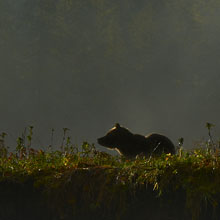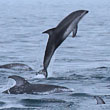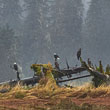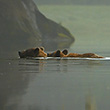Availability: Limited Edition Print - info coming soon!
In the Field
Conference in the Great Bear. Great Bear Rainforest (central BC coast), BC, Canada. September 30, 2012.
Even though the region where this image was shot is known as the Great Bear Rainforest, you'll find a lot more there than just bears. Such as Bald Eagles - there are lots and lots of Bald Eagles! And, they often perch in places that have some pretty impressive backdrops! This image contains a total of 16 eagles comprised of a mix of adults (white-headed) and juveniles (the darker birds without pure white heads). Twelve of the birds are on the logs in the foreground and are quite easy to spot - the remaining 4 are perched in trees "further back" in the image and are pretty challenging to see (you may have to search the larger version of the image - which is accessed by clicking on the main image above - pretty closely to find them all).
One of the hardest things for novice wildlife photographers to get past mentally is the thought of "filling the frame" with their subjects - to many of them ALL that wildlife photography is about is getting close to their subjects (either physically close or through the use of those huge lenses). While close-up images of wildlife can be compelling and certainly have their place, good animalscapes* (where the subject(s) are much smaller in the frame) better show the subjects in the world they live in. Like a good landscape shot, it can be very hard to pull off a good animalscape - they require that the photographer knows how to assemble a pleasing composition and also pays careful attention to the lighting conditions. There's a bit of a paradox about animalscapes - they rarely come across that well online, but often shine as prints. And, at least in my experience, they tend to SELL (as prints) much better than do close-ups of animals. Why? Simply because they have a broader appeal (or, more accurately, a broader market) - usually only a "bear lover" will buy a close up of a bear (or eagle or whatever) to hang up on their wall, whereas almost anyone can appreciate a well-composed animalscape (or eaglescape, or bearscape).
I'm not advocating that wildlife photographers should pass on good close-up shots, but keeping your eye out for good animalscapes is never a bad idea. Sometimes it takes practice to actually see good animalscpes (and envision how they'll come out), but that practice is definitely worth the time and effort!
Animalscapes are often best appreciated when see LARGE! So here's a 2400 pixel version of it for your perusal:
• Conference in the Great Bear: Download 2400 pixel image (JPEG: 1.1 MB)
ADDITIONAL NOTES:
1: This image - in all resolutions - is protected by copyright. I'm fine with personal uses of it (including use as desktop backgrounds or screensavers on your own computer), but unauthorized commercial use of the image is prohibited by law. Thanks in advance for respecting my copyright!
2: Like all wildlife photographs on this website, this image was captured following the strict ethical guidelines described in The Wildlife FIRST! Principles of Photographer Conduct. I encourage all wildlife photographers to always put the welfare of their subjects above the value of their photographs.
3: This image was captured during one of my "Into the Great Bear Rainforest" photo tours in the autumn of 2012. Each year I offer trips into two different parts of the Great Bear Rainforest as well as one to photograph aquatic mammals and oceanscapes near the northern tip of Vancouver Island. And, in selected years, I also offer photo tours to locations to capture other highly sought-after subjects, such as various owl species of the boreal forest and wildlife of Canada's Arctic. Details about these trips can be found on the Photo Tours page of this website.
*4. For a discussion of the image types I call animalscapes and enviroscapes (and the subtle distinctions between them), just go here...
Behind the Camera
Conference in the Great Bear. Great Bear Rainforest (central BC coast), BC, Canada. September 30, 2012.
Digital Capture; RAW 14-bit format; ISO 1000.
Nikon D4 paired with Nikkor 400mm f2.8 VRII lens. Hand-held from floating Zodiac. VR on and set to "normal" mode.
1/400s @ f5.6; no compensation from matrix-metered exposure setting. Auto ISO engaged with Auto shutter speed enabled.
At the Computer
Conference in the Great Bear. Great Bear Rainforest (central BC coast), BC, Canada. September 30, 2012.
RAW Conversion to 16-bit TIFF, including first-pass/capture sharpening using Capture One Pro. Two raw variants (processed from raw) differing by a total of 0.5 stops in exposure.
Further digital corrections on resulting 16-bit TIFF files using Adobe's Photoshop CS6 and Light Craft's Lightzone. Photoshop adjustments including compositing the raw conversion variants (layering and masking), selective contrast adjustment (selective curves adjustment layer), selective tweaks to exposure (also using adjustment layers), and selective sharpening for web output. Final tone tweaking performed using tonemapper/re-light tool in Lightzone.
Conservation
Conference in the Great Bear. Great Bear Rainforest (central BC coast), BC, Canada. September 30, 2012.
Ten percent of the revenue generated by this image will be donated to Raincoast.
Species Status in Canada*: This species is not designated as at risk. The Bald Eagle was listed as "Endangered" in the contiguous US states from 1967 to 1995. In 1995 it was downlisted to "Threatened". On June 28, 2007 Bald Eagles were removed from the list of endangered and threatened species - a true American conservation success story.
The Bald Eagle (Haliaeetus leucocephalus) is a very large bird of prey with broad wings. Adults possess characteristic white ("bald") heads. It takes Bald Eagles a full five years to attain their characteristic adult plumage (including their nearly pure white head and tail). In the years prior to the development of their adult plumage they are easy to confuse with Golden Eagles. Being very broad-winged Bald Eagles are able to use an energy-efficient flapping-soaring style of flight. While many people like to think of the Bald Eagle as a fierce hunter, in reality they hunt only as a last resort. More commonly they scavenge for their prey. Additionally, they often klepto-parasitize other weaker species such as Osprey, commonly stealing the other species hard-earned prey items. The Bald Eagle is, of course, the national emblem of the United States (Benjamin Franklin argued against this - his preference was for the Wild Turkey).
These Bald Eagles were photographed in the heart of the Great Bear Rainforest. While Bald Eagles are currently not under the threat of extinction, they do, of course, require suitable breeding habitat to continue to thrive. The Raincoast Conservation Society (and Foundation) is an effective and efficient organization that has been fighting for protection of this unique habitat. If you are looking for a meaningful way to contribute to the conservation of this amazing ecosystem, Raincoast will provide maximal "bang" for your conservation dollars.
*as determined by COSEWIC: The Committee on the Status of Endangered Wildlife in Canada


























